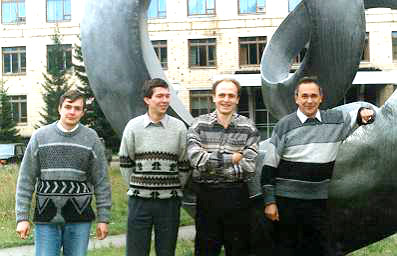
Laboratory of High Magnetic Fields


The Laboratory of High Magnetic Fields was organized by Academician Leonid Kirensky in 1969. The next head of the Laboratory was Georgy Veysig. In the period from 1973 till 1996 it got the advanced development, being led by Doctor of Phys. and Math. Sciences Boris Khrustalyev. In the period from 1996 till 2010 was head of the Laboratory Candidate of Phys. and Math. Sciences Mikhail Petrov. The current head of the Laboratory is Candidate of Phys. and Math. Sciences Kirill A. Shaihutdinov.
One of the basic directions of the Laboratory activity is the development of techniques for creation of high stationary and pulse magnetic fields. Investigations of liquid crystals, single crystal and cluster magnetics, high temperature superconductors (HTSC) in magnetic fields are being carried out. The cycle of works on creation and study of uniaxially oriented capsulated liquid crystals (CLC) has been performed in the dissipative solenoid. In magnetic field all the ensemble of nematic liquid crystal droplets suspended in a polymer matrix is oriented completely uniaxially.
Study of orientational effects in high magnetic field has shown that the Oersted-contrast characteristics of the obtained CLC films are considerably better than those of the films fabricated using the traditional technology that opens new prospects for practical application of the films. High parameters of the magnetometer created in the Laboratory in 1982 make possible to perform investigations of orientational and field-induced magnetic phase transitions in single crystal magnetics.
Precision measurements of temperature dependences of magnetization of various magnetics reveal features of their exchange interactions. HTSC studies are being carried out in the following directions: transport and magnetic properties of heterogeneous HTSC simulating the Josephson medium with a priori given parameters; magnetoresistive effect in weakly-coupled HTSC; physical properties of foamed HTSC with fractal dimensionality. Works of young scientists of the Laboratory were granted by Soros and President Scholarships.
A part of the most significant results obtained is presented in the following publications:
- Nazarov V.R., Parshin A.M., Gunyakov V.A., Zyryanov V.Y., Shabanov V.Ph. Optical anisotropy of uniaxially oriented films capsulated with a polymer of liquid crystals. // Optic journal. – 2005. – v.72. - №9. – pp.28-31.
- Balaev A.D., Bezmaternykh L.N., Gudim I.A., Temerov V.L., Ovchinnikov S.G., Kharlamova S.A., Magnetic properties of trigonal GdFe3(BO3)4 // JMMM. – 2003. – V. 258-259. – P. 532-534.
- Petrov M.I., Tetyeva T.N., Kveglis L.I., Efremov A.A., Zeer G.M., Balaev D.A., Shaihutdinov K.A., Popkov S.I., Ovchinnikov S.G. The synthesis, microstructure, transport and magnetic properties of Bi-based low density HTSC // Journ. of Materials Processing Technology. – 2005. - V. 161. - № 1-2. – P. 58-61.
|